LinkedIn is home to 40 million B2B decision-makers and 61 million senior-level influencers. The platform also is Fortune 500 companies’ social media channel of choice.
Logic follows that if your organization operates in the B2B space, you need not only a defined content marketing program but a distinct LinkedIn marketing strategy. Rather than allocating spend toward other social platforms like Twitter or Facebook, lay your chips where you know they’re most likely to be cashed in: LinkedIn.
We’re diving into several examples of B2B brands excelling at LinkedIn marketing to illustrate what lessons you might apply toward your marketing efforts.

Quick LinkedIn Stats
But first, let’s discuss just how fundamental LinkedIn is to B2B content marketing success.
- 91 percent of marketing executives rate LinkedIn as the best place to find high-quality content.
- More than 50 percent of all B2B social traffic comes from LinkedIn.
- 94 percent of B2B marketers say LinkedIn is their best distribution channel.
- 80 percent of B2B leads come from LinkedIn.
- 2 new LinkedIn accounts are created every second.
- 45 percent of people who read LinkedIn articles are managers, directors, VPs or C-suite.
With these figures in mind, it’s clear that B2B marketers who aren’t running strong LinkedIn campaigns are leaving qualified leads on the table.
So, here are six companies getting the job done.
Hays
In 2017, LinkedIn recognized recruiting firm Hays as having the “Best Company Page” on its platform. While their nearly 2.5 million follower count may attest to Hays’s prominence on social media, it’s how they converse with their audience that matters.
Hays combines helpful tips, industry research and thought-provoking articles into a stream of information that advances ideas their followers likely want to know more about. But the company doesn’t settle for the standard teaser text and hyperlink; they incorporate custom graphics, podcasts, short videos and long-form content into their LinkedIn posts, providing followers with multiple avenues with which to engage their brand.
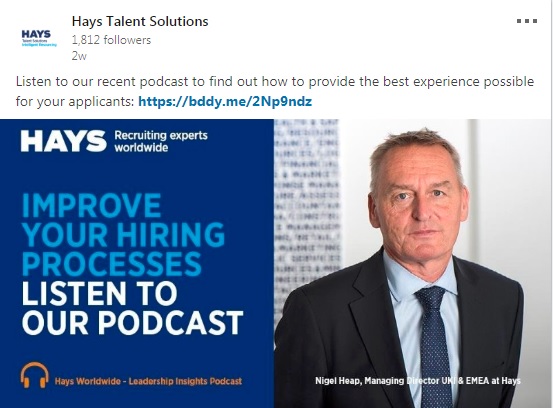
Users can discover the latest insights into HR tech, gather data on workplace productivity and pick up practical management advice within a single scroll.
Why It Works
Through its Hays Talent Solutions showcase page, Hays uses LinkedIn as a content hub. LinkedIn users aren’t on the hunt for content that helps pass the time or clickbait that’s mildly entertaining. These are B2B professionals wanting their workdays to be more efficient and their companies more successful.

Hays serves up multiple types of assets to meet that need head on. With every click, users know they will likely learn something new and be able to integrate into their staffing and workplace management practices.
Adobe
Adobe is at the forefront of its industry, so its ideas matter. As a provider of digital media platforms and creative marketing software, Adobe’s services have an array of uses.
Its LinkedIn profile mirrors this breadth of services with social content that is, at times, branded, educational, research-driven, graphical, collaborative, motivational and more.

Audiences beyond the traditional B2B persona may find their posts insightful, and that’s what Adobe tries to focus on: content that’s interesting, as opposed to content that’s conspicuously calculated for lead generation.
Why It Works
Adobe gets right what a lot of brands get wrong. They view publishing platforms and social media channels as more than just soapboxes. In reality, they’re communication corridors: Adobe has something they find interesting, and they think you might find it interesting as well, so here it is … There are fewer taglines and sales overtures and more abstract, aha moments.
This model differs from brands so constrained by narrow messaging and corporate identity that they’re afraid to even try to be unique.
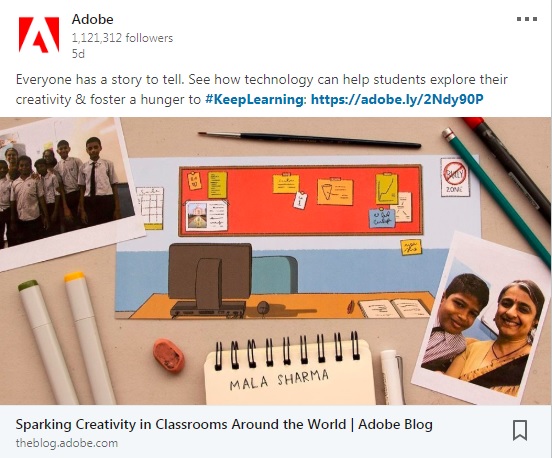
And we don’t fault those organizations. When content marketing comes down to cents and dollars, it’s difficult to invest small budgets in content that doesn’t have a clear conversion goal or that doesn’t shorten the sales cycle in any way. In this sense, Adobe has the luxury of experimentation.
But experimentation can also lead to new possibilities and revenue streams over time. Case in point: we at Brafton rewrote our product landing pages at the beginning of 2018, and since then, 70 percent of them rank on the first page of Google.
Subscribe to
The Content Marketer
Get weekly insights, advice and opinions about all things digital marketing.
Thanks for subscribing! Keep an eye out for a Welcome email from us shortly. If you don’t see it come through, check your spam folder and mark the email as “not spam.”
MailChimp
Sure, LinkedIn’s a B2B platform, but audience engagement is audience engagement. That’s what MailChimp’s LinkedIn content strategy proves with each post.
A short, auto-play video here, a photographic mashup of employees in MailChimp sweaters there, and you start to forget you’re on LinkedIn, not Instagram.
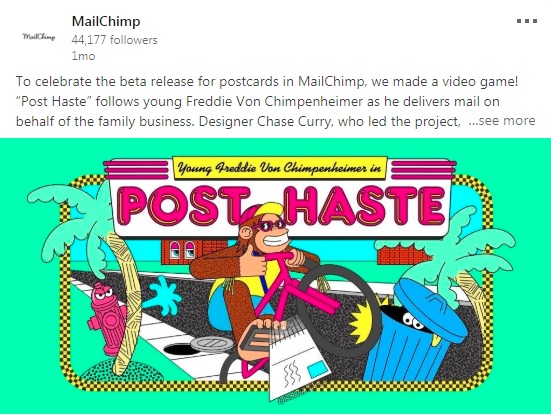
By transferring over the visual marketing practices of a platform like Instagram or even Snapchat, MailChimp successfully strikes a balance between professional and cheerful.
Why It Works
MailChimp weaves in video testimonials and written case studies to its LinkedIn publishing schedule, providing followers with real-life takeaways on the benefits of their services. So, not only do readers gain a better understanding of MailChimp products and the added trust conferred from a testimonial, but they also obtain a strong sense of the company’s personality and values.

Though LinkedIn is often a repository for industry opinions and longer form content – especially LinkedIn Pulse – it doesn’t have to be. Short videos with subtitles, custom illustrations for feature images and simple animations also have a purpose on LinkedIn, and MailChimp shows us how.
Amazon Web Services
As the primary revenue-driver for Amazon, the AWS platform essentially powers the business world through low-cost cloud infrastructure. While much of what AWS publishes on LinkedIn is brand-centric, their social team aggressively promotes new services, training around existing products and concepts that support their overall mission of global cloud deployment. In a word: They have a theme, and they stick to it.

This certainly isn’t revolutionary, and for many organizations, being so promotional may fall flat. Because AWS dominates its industry and provides services that impact virtually every aspect of our lives, however, its LinkedIn content strategy resonates. It isn’t necessarily about sales; it’s about education.
Why It Works
Each of AWS’s LinkedIn posts is effectively a mini case study on how impactful its technology is and the ways it is being utilized.
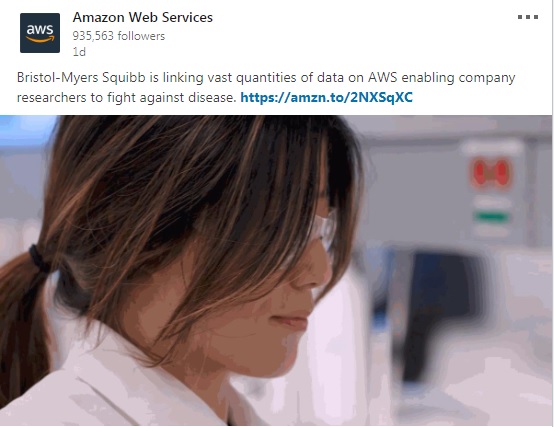
By elaborating and offering examples on the latest tech, such as machine learning and artificial intelligence, AWS co-opts part of the larger conversation around these topics. And by inputting their own expertise and use cases, they position themselves on LinkedIn as a go-to resource for timely content on important tech developments.
HubSpot
We’d be remiss if we didn’t touch on LinkedIn Ads, the targeted, self-service advertising suite that businesses use to complement their organic LinkedIn efforts.
In 2016 and 2017, HubSpot began experimenting more with paid social ads, and they uncovered a number of key findings that helped them better budget for the future. Those included:
- 9 percent conversion rate through LinkedIn Sponsored Content compared to about 2.5 percent through Google search.
- $90 per LinkedIn lead versus $125 per Google Ads (formerly AdWords) lead.
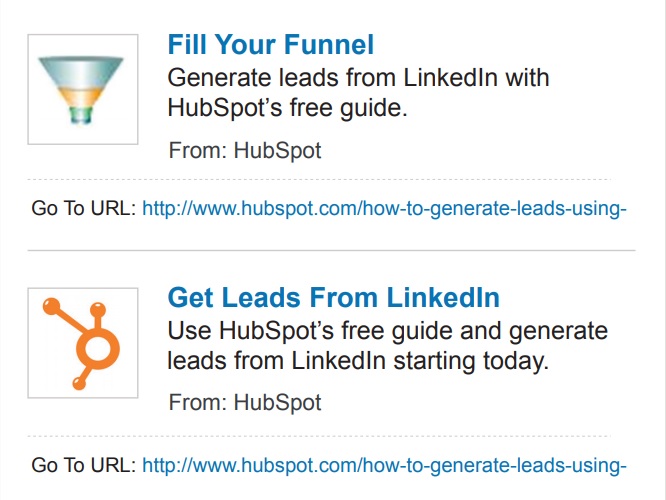
CPCs for LinkedIn ads are higher than search and other social ads, but for B2B companies, the payoff is there in the form of lower cost per lead (highly qualified lead, at that).
Why It Works
As the numbers show, social ads for targeted audiences can generate stronger ROI than even some forms of organic content; that’s the nature of operating on a more niche platform with user groups that are homed in on what they specifically desire.

In the case of HubSpot, it knew its audience overlapped substantially with LinkedIn marketers, so placing text ads directly in front of B2B users was a no-brainer. Being a marketing organization itself, HubSpot was likely able to leverage tons of its own customer data to better craft the ad creative for maximum impact.
This example highlights the necessity of using the full spectrum of LinkedIn’s offerings to more fully stand out from other business users. It also underscores how effective the platform can be in generating leads at scale.
Deloitte
Few organizations carry the B2B reputation of Deloitte, which is known to produce great content in the form of lengthy industry reports, data-driven research and insights from internal experts. And through its LinkedIn page, Deloitte posts timely, relevant content several times a day, and across different formats.
Graphical representations of survey results, video interviews of executive team members and articles summarizing proprietary trends reports are just a few of the ways Deloitte conveys its brand values to followers. The management consulting firm also prioritizes quality feature images, alternating between custom illustrations, stock imagery and simple text overlays.

Most prominently, Deloitte’s social presence covers a wide range of important business matters, such as automation, regulation, green infrastructure, smart city planning and blockchain, among others.
As a business owner or board member, Deloitte would be a great resource for developments on how technological and governmental trends may impact his or her operation.
Why It Works
Deloitte is the largest professional services network in the world, with roughly $40 billion in annual revenue. Its expertise in consulting business leaders and advising enterprises is put on display on LinkedIn, which is precisely the platform to do so.
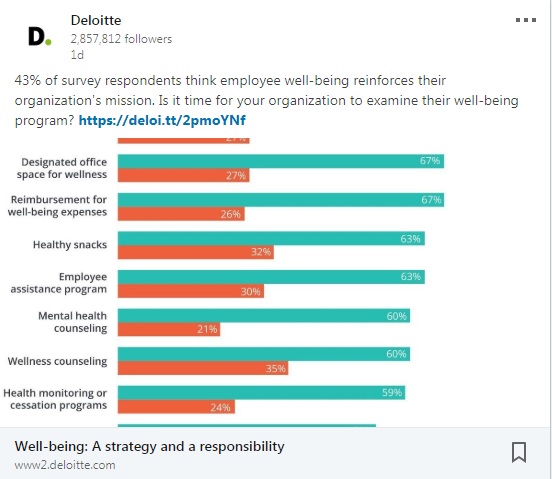
When your primary offering to customers is a somewhat nebulous service like “consulting,” it can be difficult to speak plainly, to show results, to convince others of your inherent value. But Deloitte – irrespective of its existing brand image and name recognition – uses LinkedIn as a tool for fleshing out its messaging and reinforcing what it brings to the table.
By scanning the company’s LinkedIn content, you immediately get the idea that it is abreast of business trends, has predictions for the future and employs experts who have something to offer customers of all stripes. Moreover, because senior executives and decision-makers prefer quick, visual content, Deloitte formats its posts to cater specifically to this audience.
Conclusion
In many ways, LinkedIn is a more precise platform than other social channels. Its demographic user base and intent is more homogenous, meaning its users – who on average spend only 17 minutes a month on LinkedIn – log on with more commercial intent relative to other social platforms.
Even if the initial goal of a user is networking, information-gathering or engaging with content, the underlying motive is to advance professional and organizational objectives, either now or at some point in the future.
What can be learned from the above content strategies, and how will your team refine your LinkedIn marketing moving forward?




